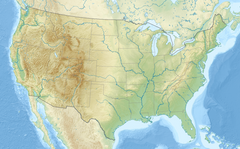Skookumchuck River
River in Washington, United States From Wikipedia, the free encyclopedia
The Skookumchuck River is a 45-mile (72 km) long[2] river located in southwest Washington, United States. It is a tributary of the Chehalis River, which is the largest drainage basin located entirely within the state.[5]
| Skookumchuck River | |
|---|---|
 Skookumchuck River in Bucoda, WA | |
| Location | |
| Country | United States |
| State | Washington |
| County | Lewis, Thurston |
| Physical characteristics | |
| Source | |
| • coordinates | 46°42′28″N 122°26′41″W[1] |
| Mouth | |
• coordinates | 46°43′10″N 122°58′55″W[1] |
| Length | 45 mi (72 km)[2] |
| Basin size | 181 sq mi (470 km2)[3] |
| Discharge | |
| • location | river mile 6.4 near Bucoda[4] |
| • average | 1,972 cu ft/s (55.8 m3/s)[4] |
| • minimum | 40 cu ft/s (1.1 m3/s) |
| • maximum | 8,560 cu ft/s (242 m3/s) |
History
The name Skookumchuck derives from Chinook Jargon: in this context, "rapids". The word skookum means "strong", and chuck means "water".[6] The Quinault Indian Nation, by way of the 1856 Treaty of Olympia, hold fishing rights on the river. Beginning in 2021, the river is allowed to be used as a year-round water bank and is the largest in the state, allowing a draw of 28,000 acre-feet of water per year.[7]
Course
The river begins with several tributaries in the Snoqualmie National Forest in the foothills of the Cascade Mountains, and flows west past the town of Bucoda, Washington to its confluence with the Chehalis River near Centralia, Washington.
Skookumchuck Dam
Summarize
Perspective

The Skookumchuck Dam was built in 1970, creating the 4-mile (6.4 km) long Skookumchuck Reservoir.[8] Its primary use is to provide water for the TransAlta coal plant and is not used for local or community water needs. The dam is an earthen bank structure measuring 190 feet (57.9 m) tall and spans 1,340 feet (408.4 m).[9]
With low water levels in the reservoir, the system provides some flood protection to communities downstream, such as Bucoda, however, the dam was not built for flood prevention.[9] The earthen dam has been part of several flood mitigation proposals to protect the Centralia and Chehalis communities from continuing overflow events.[10][11] The embankment contains a trap system in which mature steelhead are caught and transported over the spillway but existing fish passages prevent young salmon from migrating.[9]
The dam and reservoir is overseen by TransAlta and, by contract, will continue in their oversight role after the coal plant is closed at the end of 2025. At that time, water rights will revert to the city of Centralia for public consumption.[12]
Dam removal
A 2022 study to remove the dam by the Office of Chehalis Basin (OCB) estimated a cost up to $35 million, with a potential high of $80 million when factors are added for the loss of downstream water rights. The study concluded the best options were improvements to the dam to include fish passages, as well as to use the dam for flood control purposes.[7]
In June 2024, a petition to remove the dam at the termination of the Centralia Steam Generation Plant operations was filed by the Quinault Indian Nation. Requesting the removal by at least the end of 2025, the Quinault expects immediate, natural restoration of the river's flow and salmon habitat.[7]
Ecology and environment
Summarize
Perspective
The Skookumchuck River has lost several key components for a healthy river system due to human activities, such as farming and the dam. As of 2025[update], the aquatic habitat and species are considered to be lacking in diversity due to a lack of natural wood deposits and pool areas for fish. This leads to higher predation, leading fish using the river as a pass-through rather than a feed-and-rest area. Additionally, a network of dams, dikes, and removal of natural barriers has disconnected the floodplain, causing more erosion to the habitat as waters rush through the Skookumchuck during high rain and thaw events.[13]
The loss of old-growth trees and lack of native plant species is also a concern. Non-native and invasive plants have caused riparian habitats to struggle as native plants are prevented from being reestablished. The decrease in native trees and shrubs, with deep roots and shade cover ideal for the banks of the river, lead to more erosion and subsequently a lack of food and shelter for aquatic animals.[13]
A project began in mid-2024 to repair human-caused issues of the Skookumchuck system and was authorized by the Chehalis Basin Strategy. Known as the Riverbend Project, the habitat restoration efforts are in partnership or support with various state agencies such as the Chehalis Basin Board, the Office of Chehalis Basin's Aquatic Species Restoration Program, the Thurston Conservation District, and the Washington Department of Fish and Wildlife. Further collaboration includes a mix of groups and professionals working in environmental conservation. The project has helped to protect the river from agricultural and farming impacts with a focus on surface runoff, and has included the removal of invasive plants, the planting of native vegetation, a reconnection of the floodplain by creating higher flow channels, the placement of logjams, and integrating both natural river habitats with that of farms by the practice of silvopasture.[13]
The Riverbend Project is expected to continue possibly up to 2030, focusing on maintenance and monitoring of the system, adapting as needed. The $8 million effort is funded by a large association of partners in both Thurston County and Washington state.[13]
See also
References
External links
Wikiwand - on
Seamless Wikipedia browsing. On steroids.


